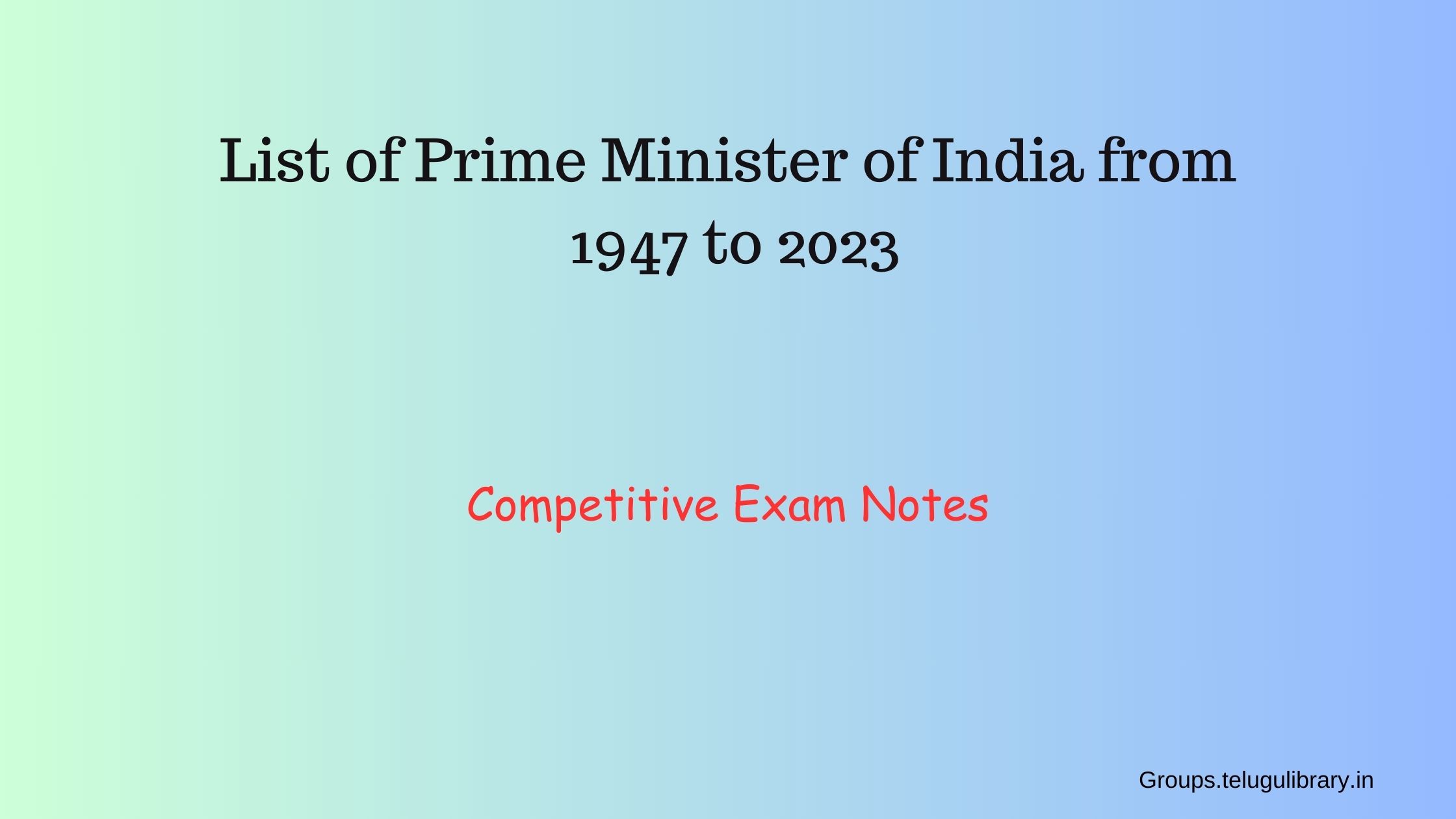List of Prime Minister of India from 1947 to 2023…
Here is a list of Prime Ministers of India from 1947 to 2023:
- Jawaharlal Nehru (15 August 1947 – 27 May 1964)
- Gulzarilal Nanda (acting) (27 May 1964 – 9 June 1964)
- Lal Bahadur Shastri (9 June 1964 – 11 January 1966)
- Gulzarilal Nanda (acting) (11 January 1966 – 24 January 1966)
- Indira Gandhi (24 January 1966 – 24 March 1977)
- Morarji Desai (24 March 1977 – 28 July 1979)
- Charan Singh (28 July 1979 – 14 January 1980)
- Indira Gandhi (14 January 1980 – 31 October 1984)
- Rajiv Gandhi (31 October 1984 – 2 December 1989)
- Vishwanath Pratap Singh (2 December 1989 – 10 November 1990)
- Chandra Shekhar (10 November 1990 – 21 June 1991)
- P. V. Narasimha Rao (21 June 1991 – 16 May 1996)
- Atal Bihari Vajpayee (16 May 1996 – 1 June 1996)
- H. D. Deve Gowda (1 June 1996 – 21 April 1997)
- I. K. Gujral (21 April 1997 – 19 March 1998)
- Atal Bihari Vajpayee (19 March 1998 – 22 May 2004)
- Manmohan Singh (22 May 2004 – 26 May 2014)
- Narendra Modi (26 May 2014 – Till date)
With Details:
- Jawaharlal Nehru (15 August 1947 – 27 May 1964):
- Key figure in the Indian independence movement.
- First Prime Minister of India.
- Played a crucial role in shaping political and economic policies.
- Gulzarilal Nanda (Acting, 27 May 1964 – 9 June 1964):
- Acting Prime Minister between Nehru and Shastri.
- Lal Bahadur Shastri (9 June 1964 – 11 January 1966):
- Succeeded Nehru.
- Led India during the Indo-Pakistani War of 1965.
- Remembered for the slogan “Jai Jawan Jai Kisan” (“Hail the Soldier, Hail the Farmer”).
- Gulzarilal Nanda (Acting, 11 January 1966 – 24 January 1966):
- Again assumed the role of acting Prime Minister after Shastri’s death.
- Indira Gandhi (24 January 1966 – 24 March 1977):
- First female Prime Minister of India.
- Implemented significant policies.
- Imposition of a state of emergency in 1975.
- Morarji Desai (24 March 1977 – 28 July 1979):
- First non-Congress Prime Minister.
- Focused on economic reforms.
- Resigned due to challenges.
Next..
- Charan Singh (28 July 1979 – 14 January 1980):
- Served during economic difficulties and political instability.
- Indira Gandhi (14 January 1980 – 31 October 1984):
- Returned to power.
- Faced challenges including Operation Blue Star.
- Assassinated in 1984.
- Rajiv Gandhi (31 October 1984 – 2 December 1989):
- Youngest Prime Minister.
- Focused on modernization and economic liberalization.
- Vishwanath Pratap Singh (2 December 1989 – 10 November 1990):
- Implemented Mandal Commission recommendations and economic reforms.
- Chandra Shekhar (10 November 1990 – 21 June 1991):
- Served for a short period.
- Faced challenges such as political instability and economic issues.
- P. V. Narasimha Rao (21 June 1991 – 16 May 1996):
- Initiated economic reforms and liberalization.
- Transformed India’s economic landscape.
- Significant foreign policy developments.
- Atal Bihari Vajpayee (16 May 1996 – 1 June 1996):
- Short-term Prime Minister.
- Prominent leader of the Bharatiya Janata Party (BJP).
- H. D. Deve Gowda (1 June 1996 – 21 April 1997):
- Key figure in regional politics.
- Served as Prime Minister in a coalition government.
- I. K. Gujral (21 April 1997 – 19 March 1998):
- Known for the “Gujral Doctrine” in foreign policy.
- Led a coalition government.
- Atal Bihari Vajpayee (19 March 1998 – 22 May 2004):
- Second term saw significant economic and infrastructure development.
- India conducted nuclear tests in 1998.
- Manmohan Singh (22 May 2004 – 26 May 2014):
- Economist.
- Focused on economic reforms.
- Implemented flagship social welfare programs.
- Narendra Modi (26 May 2014 – present as of November 2023):
- Leader of the BJP.
- Became Prime Minister in 2014.
- Initiatives include “Make in India” and “Swachh Bharat Abhiyan.”
For History and Cultural Heritage of India Topics and Mcqs
Fundamental rights in India constitution
